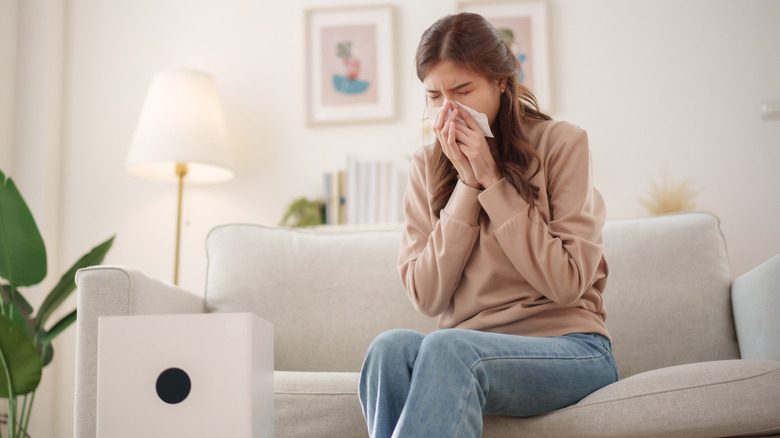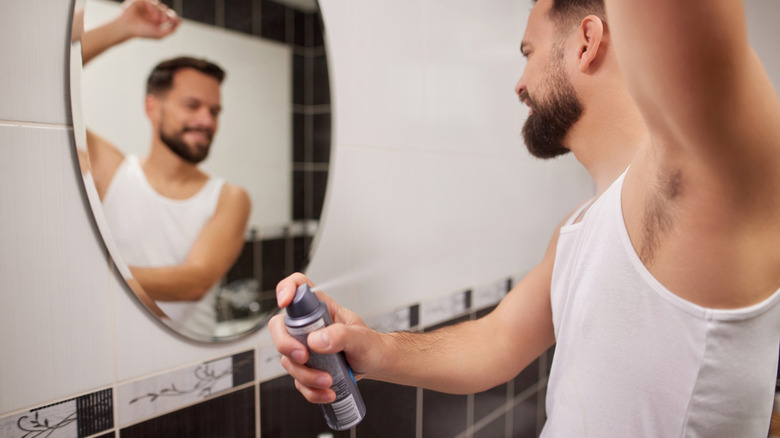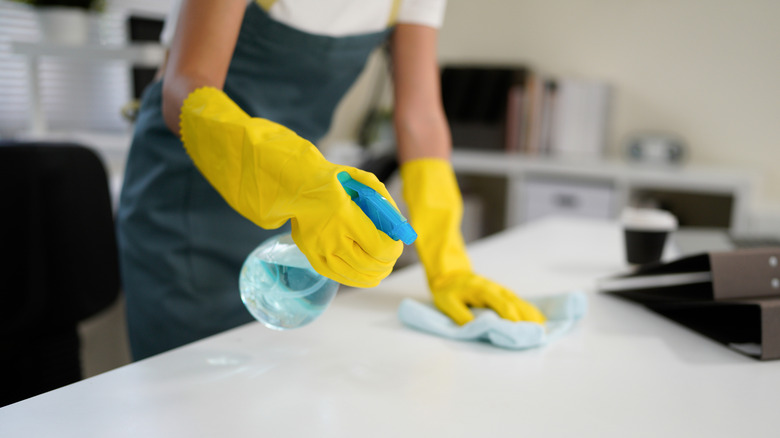4 Types Of Air Pollution That Are Probably Already In Your Home (& How To Get Rid Of It)
We all want to think of our homes as our indoor sanctuaries — a place sealed off from the grit and grime of the outdoor world. But before you lean too hard into embracing 2025's cozy homebody era design trend, you might want to think about whether your indoor refuge is as clean and safe as you want it to be. Unfortunately, the every day rituals that make our spaces so comforting — lighting candles, doing the laundry, cooking dinner — can be introducing air pollution into every breath we take.
If that sounds bad, it's because it is. Poor indoor air quality can negatively impact all aspects of health. It can increase anxiety in the short-term, and have longer-lasting effects on brain health in the long run. Indoor pollution can cause or exacerbate chronic conditions like asthma or heart disease, and cause symptoms like headaches, fatigue, or irritated eyes and throats.
But don't worry — it's not all doom and gloom. In recent years, researchers have identified the main types of indoor air pollution and where they come from, like particulate matter, volatile organic compounds, semi-volatile organic compounds, and noxious gases. Even more critically, they've uncovered tons of ways to make sure they're not welcome at your place. Learning more about each type can help you take manageable steps to improve your home's air quality.
Particulate matter
Particulate matter, or PM, is the broad term for the tiny solid or liquid particles found in the air. Some are big enough to see; others require a microscope. The PM you'd be most likely to find in the average household would be dust, dirt, mold spores, or smoke. Cleaning supplies can be a source of PM, as can the supplies for hobbies like woodworking or 3D printing. Other households might have more sources, like pets, smokers, or gas stoves. If you frequently open your windows, you may unwittingly be letting in sources of outdoor PM, like vehicle exhaust, pollen, or factory emissions.
PM is tiny but mighty. The particles' small size lets them work their way deep into the lungs and heart to wreak havoc. Exposure to them has been linked to issues like nonfatal heart attacks, aggravated asthma, lung disease, and overall difficulties in breathing or sleeping. A huge step in getting rid of particulate matter in your home is identifying its biggest sources. Stay on top of vacuuming and dusting at least once a week. And do both chores the right way — use a vacuum with HEPA filters, and rather than just sweeping dust around with a duster, make sure you use a wet cloth to pick it up and dispose of it. Keep an eye on outdoor air quality so you minimize opening the windows on bad days.
Smoke is another source of particulate matter. If you have a gas stove, make sure to choose the right range hood for your home and use cooking oils with a lower smoke point to minimize smoke. If you're especially sensitive to PM, you might also want to limit the use of candles.
Volatile organic compounds
Volatile Organic Compounds, or VOCs, are released as gases from a variety of solid and liquid sources. You may already know how to stay safe some of the sources, like paint stripper or flooring materials. But there are other VOC-heavy products you may be using casually without knowing, like houseplant fertilizer, aerosol sprays, and cleaning and beauty products. There are different types of VOCs and exposure levels can vary wildly. But they have been linked to a wide variety of serious health issues including headaches, nausea, skin reactions, dizziness, and damage to the liver, kidneys, and central nervous system.
To minimize the VOCs in your home, get smart about reading labels. Look for terms like "Low VOC" or "No VOC," or check items using the Environmental Working Group's guide to more environmentally friendly skincare or cleaning products. A general rule of thumb is that the more artificial fragrances a product has, the more likely it would be to contain harmful VOCs. Another name to watch out for is benzene, which can be found in some cleaning products or glues. If you do use products that could contain VOCs, make sure to ventilate your space as well as you can while using.
Semi-volatile organic compounds
Related to VOCs, semi-volatile organic compounds (SVOCs) are also chemicals released into the air, but they are typically more likely than VOCs to settle onto surfaces or attach to other particles. You'll find them in similar sources to VOCs, like flame retardants, home pesticides, and cleaning products.
As with PM and VOCs, proper cleaning and ventilation is a good way to minimize the risk of SVOCs in your home. Wet dusting and vacuuming with HEPA filters is crucial, as is reading labels for harmful ingredients. You might also consider the use of an air purifier, especially one with a HEPA filter. A good one will trap harmful materials and filter cleaner air into your home. It's especially smart to think about if you live with kids, older adults, or other people who have chronic conditions that make them more susceptible to poor indoor air quality. Thankfully, there are plenty of air purifiers that don't break the bank, helping you maintain a healthy indoor atmosphere while sticking to your budget.
Noxious gases
Noxious gases include harmful gases like carbon monoxide, nitrogen dioxide, or gases that can be released from different mixtures of powerful cleaning agents. At high exposures, these are very dangerous substances, causing dizziness, nausea, inflamed airways, and trouble breathing. Death is even possible, though only at very high levels.
You probably already know that you should have carbon monoxide sensors around to spot big leaks, and have been warned to never mix certain cleaning products like bleach with others like vinegar or ammonia. But many people don't realize they may be exposed to low levels of noxious gases in or around their homes — and those levels can be harmful, too.
Take nitrogen dioxide, which is produced from burning fuels. If you live in a heavily polluted area or near a major roadway, it's important to keep your windows closed and ventilation high to limit the exposure. Low-level carbon monoxide poisoning can happen, too, and be super tough to spot. To make sure you're not exposed, hire professionals to do yearly checks on potential exposure outlets like gas water heaters, dryers, or stoves, fireplaces, and oil or gas furnaces.




